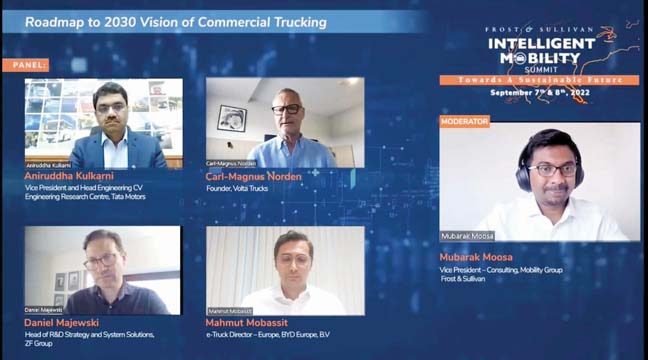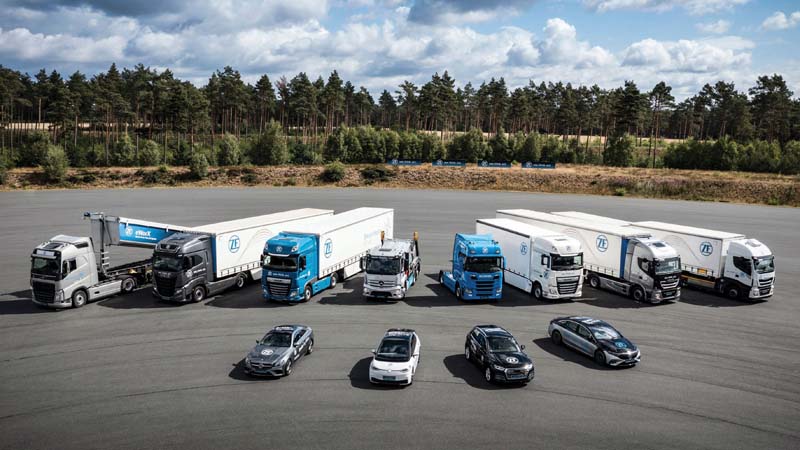At the Frost & Sullivan, 14th Annual Intelligence Mobility Summit, the adoption of an innovation-led growth path was hailed. Prateek Pardeshi and Deepti Thore checked on the growth models for sustenance.
 The fundamentals of the mobility industry are changing and so are customer preferences and expectations. The convergence of autonomous, connected, electric and shared mobility technologies is radically altering the way people move around, live, work, and engage with their environment. To address these changes, Frost & Sullivan hosted 14th Annual Intelligent Mobility Summit (IMS) themed as “Towards Sustainable Future”. The pandemic has accelerated this process of transformation, while offering stakeholders the opportunity to reset their future in the direction of sustainable, innovation-led growth models. While the industry is working towards de carbonisation and carbon-neutral manufacturing with the rising emission levels, adopting clean energy practices across the mobility value chain have become critical.
The fundamentals of the mobility industry are changing and so are customer preferences and expectations. The convergence of autonomous, connected, electric and shared mobility technologies is radically altering the way people move around, live, work, and engage with their environment. To address these changes, Frost & Sullivan hosted 14th Annual Intelligent Mobility Summit (IMS) themed as “Towards Sustainable Future”. The pandemic has accelerated this process of transformation, while offering stakeholders the opportunity to reset their future in the direction of sustainable, innovation-led growth models. While the industry is working towards de carbonisation and carbon-neutral manufacturing with the rising emission levels, adopting clean energy practices across the mobility value chain have become critical.
According to Frost & Sullivan, growing awareness on environmental issues, evolving consumer preferences, and regulatory imperatives are incubating new technology enablers in the form of Connected vehicles, Autonomous driving, Shared mobility and Electromobility (C.A.S.E.). Allied with this is the emergence of innovative mobility solutions like ‘mobility-as-a service’ and ‘lifestyle-as-a-service’. Meanwhile, logistics supply chains are aligning with trends like ‘Innovating to Zero’ and electrification too. Increasing end-of-life vehicle waste is compelling the need to pay greater attention to bringing in transparency and accountability in the mobility ecosystem. Circular economy and battery recycling concepts are highlighting how environmentally-friendly reduce, reuse, recover and recycle practices can be powerful tools for sustainable growth and competitive differentiation.
Cutting-edge technologies are anchoring shared mobility modes like car sharing, bike sharing, micro mobility, and peer-to-peer ride sharing. Advanced connectivity and autonomy technologies are heralding a highly disruptive shift toward software-defined vehicles. The transformation of cars into smart phones on wheels will push the mobility industry into an uncharted territory. Stakeholders will have to find ways to build a future defined by resilient and responsible growth. To drive the industry on this path of growth, the two-day event, brought together industry experts, policy makers, investors and innovators on a single digital platform.
Profitability & Sustainability
 Darrell Huntsman, Chief Executive Officer, Frost & Sullivan in his opening speech mentioned that the mobility ecosystem has become really complex and is facing many challenges. “A response to these challenges is not last-mile mobility but safe and sustainable mobility,” he stressed. He was of the opinion that the need is to adopt technology and solutions that continually advance sustainability agendas. After witnessing no changes for almost a century, the mobility industry saw sweeping and unprecedented transformation in the last decade in terms of product, pricing, place and promotion, highlighted Vivek Vaidya, Associate Partner and Senior Vice President, Mobility Practice, Asia Pacific, Frost & Sullivan. Products are more zero-emission focused, and more autonomous and connected; pricing has become more personalised and products are catering to customers changing value perceptions; the sales are no more restricted to showrooms but have become omni-channel and promotions are getting more and more personalised. Focused on the zero emission, battery will become the new engine, opined Vaidya. More than pricing, mobility-as-a-service and connectivity as-a-service will play a major part. 25 per cent of the vehicles will be sold online by 2025. To address these changes there are certain solutions which need to be looked at.
Darrell Huntsman, Chief Executive Officer, Frost & Sullivan in his opening speech mentioned that the mobility ecosystem has become really complex and is facing many challenges. “A response to these challenges is not last-mile mobility but safe and sustainable mobility,” he stressed. He was of the opinion that the need is to adopt technology and solutions that continually advance sustainability agendas. After witnessing no changes for almost a century, the mobility industry saw sweeping and unprecedented transformation in the last decade in terms of product, pricing, place and promotion, highlighted Vivek Vaidya, Associate Partner and Senior Vice President, Mobility Practice, Asia Pacific, Frost & Sullivan. Products are more zero-emission focused, and more autonomous and connected; pricing has become more personalised and products are catering to customers changing value perceptions; the sales are no more restricted to showrooms but have become omni-channel and promotions are getting more and more personalised. Focused on the zero emission, battery will become the new engine, opined Vaidya. More than pricing, mobility-as-a-service and connectivity as-a-service will play a major part. 25 per cent of the vehicles will be sold online by 2025. To address these changes there are certain solutions which need to be looked at.
 The need is to change from automotive to a mobility mind set. Powertrain will change from engine to battery; product segment will change from horsepower to computing power; efficiency of operations will change from mass production to personalisation or customisation. In terms of the span of control, the need is to worry about energy source than the tier n suppliers. More than customer satisfaction, engaging the customers will be more crucial. The Key Performance Indicator (KPI) which was market share earlier for the industry will now be more inclined towards share of mobility. Continuous cash flow is also among the very crucial factors. The need is to improve profit margins. “Sales of the vehicle should not be the end of the vehicle cash flow cycle but should be the beginning,” stated Vaidya. Carbon which is buried under the sustainability report will now move to the P & L report. By 2040, most of the companies want to be carbon neutral but this can only happen if they purchase carbon credits. “Carbon footprint saved is carbon credit earned,” he mentioned. Most of the OEMs are also looking at a comprehensive sustainability strategy to improve units in operation. To sum up: three factors which are key for success are change to mobility mind set, look at profitable goals and move to sustainability for orientation.
The need is to change from automotive to a mobility mind set. Powertrain will change from engine to battery; product segment will change from horsepower to computing power; efficiency of operations will change from mass production to personalisation or customisation. In terms of the span of control, the need is to worry about energy source than the tier n suppliers. More than customer satisfaction, engaging the customers will be more crucial. The Key Performance Indicator (KPI) which was market share earlier for the industry will now be more inclined towards share of mobility. Continuous cash flow is also among the very crucial factors. The need is to improve profit margins. “Sales of the vehicle should not be the end of the vehicle cash flow cycle but should be the beginning,” stated Vaidya. Carbon which is buried under the sustainability report will now move to the P & L report. By 2040, most of the companies want to be carbon neutral but this can only happen if they purchase carbon credits. “Carbon footprint saved is carbon credit earned,” he mentioned. Most of the OEMs are also looking at a comprehensive sustainability strategy to improve units in operation. To sum up: three factors which are key for success are change to mobility mind set, look at profitable goals and move to sustainability for orientation.
Decarbonisation
Focusing on the theme, Zero Emission Vehicles : Decarbonisation Driving Sustainable Mobility, Ponz Pandikuthira, Global Vice President, Marketing, Nissan opined that the need is to drive innovation to enrich people’s lives and thereby adopt sustainable mobility on a path to zero-emissions. Addressing the major shifts that are shaping the future, Pandikuthira pointed to climate change, social issues and conscious customers as major driving factors. The need is to invest ambitiously in sustainable mobility. As per the Nissan Ambition 2030, since 2010 the company has invested around one trillion JPY in electrification and plans to invest two trillion by 2026. The company plans to expand its electric mobility line-up further by 2030.
These changes will not happen overnight hence the need is to look at e-power as the option where the electric powertrain will get the power from the battery pack. That is an innovative pathway to enable electric driving experience, instant and powerful acceleration through enabling regenerative braking, offering motor drive, high level cabin quietness and intelligent engine switching along with excellent fuel economy.
Building battery production capacity is also deemed fit to create an electric future. According to Pandikuthira, by 2026 battery production capacity is expected to increase to 52 GWh and to 130 GWh by 2030. It is also very important to build a sustainable and efficient EV ecosystem. The need is to have efficient batteries to power electric vehicles and launch them in countries with proper CO2 credits. The need is to offer energy solutions through V2X, to gain financial benefits, have backup power, grid stabilisation and use of green energy. When the electric vehicle gets old, the need is to have a repurpose program in place for reusing the batteries and increasing EV residual value for carbon emissions reduction.
With the purpose of adopting zero waste policy, the need is to recycle and generate value. Creating a distributable energy model-V2X is required for stabilising the grid. Investing in infrastructure for charging and ensuring reliable access to charging are also very crucial. Speaking of introducing All-Solid State Batteries (ASSB) by 2028, Pandikuthira mentioned that these make EVs more efficient and more accessible. They also help reduce charging time and increase energy density. Nissan aims at reducing carbon emissions in its plant by 40 per cent through its intelligent factory where renewable energy is used to power the factory, EV36Zero EV hub in Sunderland and the Canton Plant which is focused on building EVs in the US.
Powering innovation

Dr Jose Pereira, Director, Frost & Sullivan drew attention to the key challenges and opportunities foreseen on the path to attain zero-emissions. Transport sector has the highest dependency on fossil fuels of any sector and accounts for 37 per cent of carbon emissions, he stated. He drew attention to five key trends required to power innovation and growth in the industry to accelerate its drive towards sustainable mobility. These include digital engineering for zero prototypes which is a simulation driven development, modular and software-defined platforms, digital twins for continuous in-use product optimisation, data collection and human-AI collaborative engineering and tech-driven business models to unlock value pools.
Battery technology
 Prajyot Sathe, Research Manager, Frost & Sullivan spoke of the advancement in battery technology and an expected shift towards 800V architecture. He drew attention to key upcoming trends in the field of battery and battery infrastructure. These include global emergence of giga factories, charging infrastructure development, next-gen battery tech-module less battery packs, transition to SIC-based power electronics, wireless BMS, and electrification of fleets.
Prajyot Sathe, Research Manager, Frost & Sullivan spoke of the advancement in battery technology and an expected shift towards 800V architecture. He drew attention to key upcoming trends in the field of battery and battery infrastructure. These include global emergence of giga factories, charging infrastructure development, next-gen battery tech-module less battery packs, transition to SIC-based power electronics, wireless BMS, and electrification of fleets.
Future roadmap of CV Industry
As the CV industry is transitioning from cleaner alternatives, the fueling or charging infrastructure needs a revamp too. The CNG and LNG penetration in India in recent times have gone up. The overall sector of CVs has seen alternate drivetrains penetrate different segments, from SCVs to HCVs including buses for attaining lower TCO. Commenting on the penetration of CNG in the Indian CV market he said, “As the sales units go higher the CNG refuelling pumps and infrastructure availability must get the due attention too.” Later, the gasification trends look promising with the industry looking at LNG as a long-haul choice. Notably, Annriddha also mentioned about the research work happening around the long range of CNG trucks, where in the trucks would be capable of crossing 1000 kms one a full tank, this is achievable and testimony to it are the recently rolled out models from Ashok Leyland and Blue Energy Motors in partnership with IVECO group company FPT.
As far as battery electric trucks are concerned, charging infrastructure is a big issue. Today we have 48V architecture, 96V and so on. MBEV trucks have already entered the mining segment with companies like BYD and Volvo Trucks having the technology. Hydrogen powered drivelines have exciting prospects too. Annirudha hoped for experimental launches or a captive customer for pilot runs. Various efforts are under the process working on auto components and other OEMs. As a forecast, he projected the ecosystem to be up and running over the next half a decade.
Further Daniel Majewski, Head of Strategy R&D and System Solutions, ZF, Commercial Vehicle Solutions, brought it into context. He said,“The key to success is to make autonomous solutions adaptable and interoperable.” Connecting the dots, Annirudhha mentioned, the work on autonomous trucks has already begun in India. Solutions that will be apt for Indian will need to align with the wide CV segment. India has trucks starting from 14- to 48-tonne having multi- axle configurations. Moreover, the Total Cost of Ownership (TCO) and active safety assist features will continue to be prioritised. These will have to cater to the price sensitivity in the Indian market. ADAS level-1 trucks have already hit the roads from the Tata Motors stable, for instance.
Autonomous trucks have a long way to go though. The concept is not just to make the truck work independent of the driver but also focusing on the entire ecosystem. For example, if the truck is delivering the goods, there should be someone to receive it. Commenting on the future, Carl-Magnus Norden, Founder, Volta Trucks said, “Autonomous trucking has a huge growth potential, we are witnessing the start of it, within the span of 10-15 years we will move beyond diesel engines completely.” Autonomous solutions can also be among the major contributors for public transport.
Future Mass Transit
Traffic congestion in metropolitan areas is like an active volcano just ready to erupt. Let’s take Mumbai for instance, covering 10 kms in peak hour is a nightmare. Improving public transport will encourage users to opt for it over private modes. Here, autonomy was split into a three-part consideration: ecurity, ease of use and cost reduction. A comparison of e-bus annual running costs was looked at with autonomous shuttle TCO.
While ebuses account for 65 per cent costs attributed to human capital, the shuttles account for 30 per cent on the same scale. Back in July 2020, Navya launched the autonomous L4 shuttle service in a closed environment with a vision on aspects like a structured value chain, political dynamics, legal framework, realistic expectations and technology breakthrough.
Today’s shared mobility market is valued about USD 835 bn which is shared across (Carsharing, Ridehailing, DRT, Public transport, etc). By 2030, this market is expected to grow to USD two trn courtesy a significant growth in DRT and public transport stated Shwetha Surender, Director, Frost and Sullivan. With the emphasis on autonomous vehicles, the industry could see mass adoption with LIDAR and autonomous software costs expected to go down by 2025 and 2030 respectively.
Future-Gen Automotive
For growth of any industry collaboration is of utmost importance. A tug of war between automotive manufacturers and IT Giants has always been in the picture. The value proposition for software- defined vehicle for automotive ecosystem brings faster development time, highly scalable business models, and reduced detection and overall complexity of vehicle. According to Somasundharam Muthumanickam, Lead Software Architect, Automated Driving, ZF Group, ” The conventional way of development for new technology can be faster, the overall complexity where a vehicle uses multiple ECUs can be much simpler, while today many vehicles are a mix of electronics and hardware this is where software based automotive ecosystem has the advantage.” Further Anuj Jain, Mobility Expert (Strategy & Business Development, AWS Automotive) VP Bosch, stated vehicles today roll out from the showroom with all loaded features. In the near future, with software capabilities they will be regularly updated with features on the personalisation front and improving safety features.




















